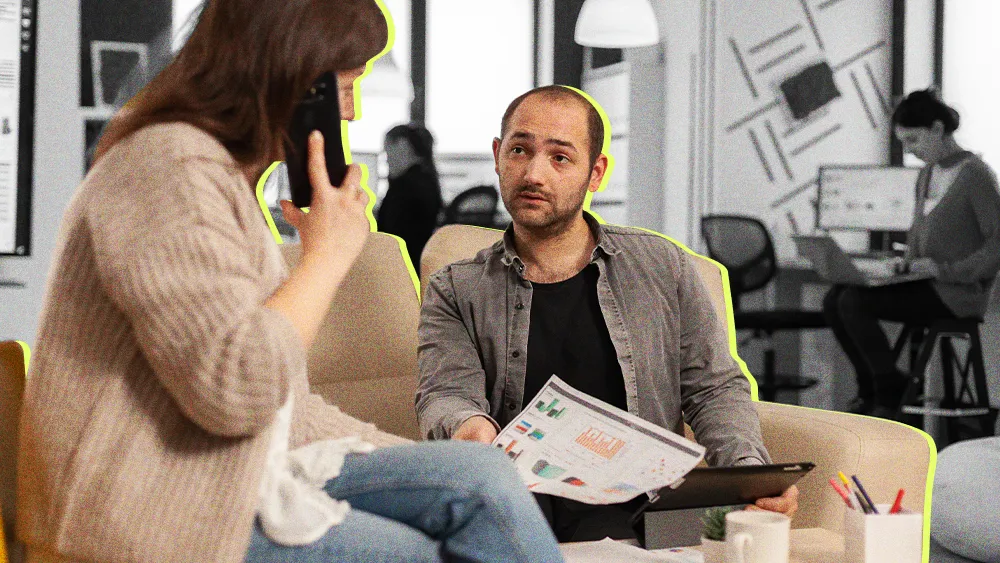Leaders lean into ‘unstructured time’ to build culture in remote-first companies

Key Points
With the decline of the monoculture, building team connection in a remote world has become a central challenge for leaders.
Annie Tsai, COO of Interact, warns against forcing a “bestie culture” and instead advocates for creating “intentional unstructure” where organic relationships can form.
Tsai explains that this approach—using tactics like low-pressure in-person gatherings and voluntary social clubs—builds the authentic trust that is critical to the bottom line.
You need shared, non-work moments in order to build trust and rapport. And that does bleed back into the workplace. Trust and rapport with your teammates are necessary for everything from buy-in to decision-making.

Annie Tsai
Chief Operating Officer
Interact
Between fragmented media and remote work, rare zeitgeist moments have taken on a new and surprising function. They are becoming one of the last true “water coolers”—a shared experience that can seep into the workplace, spark conversation, and, for leaders who understand their value, become a powerful tool for building more effective teams. The seemingly frivolous conversations about the big game or the latest album drop are the bedrock of something far more critical to the bottom line: trust.
The release of Taylor Swift’s next album The Life of a Showgirl is set to be a major water cooler moment this year. A new study anticipates a Swift Shift, with 58% of Swifties saying they openly discuss pop culture with their coworkers.
We spoke with Annie Tsai, the Chief Operating Officer at quiz-building platform Interact and a board leader at the global community Moms in Tech. For her, the link between a shared cultural moment and a high-performing team is obvious. “You need shared, non-work moments in order to build trust and rapport,” she said. “And that does bleed back into the workplace. Trust and rapport with your teammates are necessary for everything from buy-in to decision-making.”
A rare connection: This value is magnified by the simple fact that these moments are becoming increasingly scarce. So when they do happen, they create a major opportunity for connection that Tsai has seen firsthand. “Everybody used to watch the same show at the same time, or the Super Bowl would happen, and everybody would watch,” she recalled. “It just doesn’t happen that often anymore where you can have that shared moment.” When the news of Taylor Swift’s engagement broke, she saw the effect immediately. “One of our team members is from Philly, close to Swift’s hometown, so she was crying tears of happiness. Everyone was talking with her about the engagement.”
Manufacturing these connections is a central challenge of the modern workplace. In a remote or hybrid world, there are no accidental Slack messages or spontaneous hallway chats. The solution, Tsai argued, is not to force the interactions themselves, but to intentionally create unstructured space for them to occur. “Forced fun” or other overly engineered initiatives often backfire, leaving employees feeling less connected and more annoyed.
Intentionally unstructured: At her fully remote company, the answer is to bring the team together in person three times a year. The goal isn’t a packed agenda of strategy sessions, but something simpler. “It’s about physically being together, working next to each other, and having those moments where we can have side conversations, share meals, and experiences,” she explained. “The leadership goal is to keep things loose enough that organic moments can materialize.”
Authenticity over forced connection: This approach requires a delicate touch. Tsai warned against a top-down approach, advocating instead for a culture that enables, rather than mandates, connection. “A lot of folks are okay with not having deep, personal relationships with their coworkers,” she said. “They just want to go to work, and that’s totally fine. Trying to inject a ‘bestie culture’ into that will feel very inauthentic and will probably result in a call to HR.”
Instead, the key is to look for organic needs and create a safe platform. She shared an example from a previous company where a team member with a passion for cooking was going through a tough time. The solution was a voluntary, monthly dinner club. It gave the employee a chance to shine, and it allowed colleagues to connect in a low-pressure environment where the focus was on the food, not forced team-building. It created an environment that was “welcoming and not creepy.”
Ultimately, the bonds that forge the most resilient and trusting teams are formed by communal challenges or celebrations. Tsai recalled the powerful connections created during late nights at startups, struggling to debug code at 10 p.m. alongside her fellow engineers. But it’s in the celebrations, big and small, that the most lasting memories are made. She recounted a team-building event where, instead of paying for expensive tickets to a Giants game, she took her team of fifty on the cheapest boat in the San Francisco Bay to dock in McCovey Cove. They could hear the game and hang out together in an informal setting.
“It was just a wonderful night under the stars,” Tsai said. “There was a lot happening around us, but people remember the conversations and connections made in that moment.”
A lot of folks are okay with not having deep, personal relationships with their coworkers. They just want to go to work, and that's totally fine. Trying to inject a 'bestie culture' into that will feel very inauthentic and will probably result in a call to HR.

Annie Tsai
Chief Operating Officer
Interact
A lot of folks are okay with not having deep, personal relationships with their coworkers. They just want to go to work, and that's totally fine. Trying to inject a 'bestie culture' into that will feel very inauthentic and will probably result in a call to HR.

Annie Tsai
Chief Operating Officer
Interact
Related articles
TL;DR
With the decline of the monoculture, building team connection in a remote world has become a central challenge for leaders.
Annie Tsai, COO of Interact, warns against forcing a “bestie culture” and instead advocates for creating “intentional unstructure” where organic relationships can form.
Tsai explains that this approach—using tactics like low-pressure in-person gatherings and voluntary social clubs—builds the authentic trust that is critical to the bottom line.

Annie Tsai
Interact
Chief Operating Officer

Chief Operating Officer
Between fragmented media and remote work, rare zeitgeist moments have taken on a new and surprising function. They are becoming one of the last true “water coolers”—a shared experience that can seep into the workplace, spark conversation, and, for leaders who understand their value, become a powerful tool for building more effective teams. The seemingly frivolous conversations about the big game or the latest album drop are the bedrock of something far more critical to the bottom line: trust.
The release of Taylor Swift’s next album The Life of a Showgirl is set to be a major water cooler moment this year. A new study anticipates a Swift Shift, with 58% of Swifties saying they openly discuss pop culture with their coworkers.
We spoke with Annie Tsai, the Chief Operating Officer at quiz-building platform Interact and a board leader at the global community Moms in Tech. For her, the link between a shared cultural moment and a high-performing team is obvious. “You need shared, non-work moments in order to build trust and rapport,” she said. “And that does bleed back into the workplace. Trust and rapport with your teammates are necessary for everything from buy-in to decision-making.”
A rare connection: This value is magnified by the simple fact that these moments are becoming increasingly scarce. So when they do happen, they create a major opportunity for connection that Tsai has seen firsthand. “Everybody used to watch the same show at the same time, or the Super Bowl would happen, and everybody would watch,” she recalled. “It just doesn’t happen that often anymore where you can have that shared moment.” When the news of Taylor Swift’s engagement broke, she saw the effect immediately. “One of our team members is from Philly, close to Swift’s hometown, so she was crying tears of happiness. Everyone was talking with her about the engagement.”
Manufacturing these connections is a central challenge of the modern workplace. In a remote or hybrid world, there are no accidental Slack messages or spontaneous hallway chats. The solution, Tsai argued, is not to force the interactions themselves, but to intentionally create unstructured space for them to occur. “Forced fun” or other overly engineered initiatives often backfire, leaving employees feeling less connected and more annoyed.

Annie Tsai
Interact
Chief Operating Officer

Chief Operating Officer
Intentionally unstructured: At her fully remote company, the answer is to bring the team together in person three times a year. The goal isn’t a packed agenda of strategy sessions, but something simpler. “It’s about physically being together, working next to each other, and having those moments where we can have side conversations, share meals, and experiences,” she explained. “The leadership goal is to keep things loose enough that organic moments can materialize.”
Authenticity over forced connection: This approach requires a delicate touch. Tsai warned against a top-down approach, advocating instead for a culture that enables, rather than mandates, connection. “A lot of folks are okay with not having deep, personal relationships with their coworkers,” she said. “They just want to go to work, and that’s totally fine. Trying to inject a ‘bestie culture’ into that will feel very inauthentic and will probably result in a call to HR.”
Instead, the key is to look for organic needs and create a safe platform. She shared an example from a previous company where a team member with a passion for cooking was going through a tough time. The solution was a voluntary, monthly dinner club. It gave the employee a chance to shine, and it allowed colleagues to connect in a low-pressure environment where the focus was on the food, not forced team-building. It created an environment that was “welcoming and not creepy.”
Ultimately, the bonds that forge the most resilient and trusting teams are formed by communal challenges or celebrations. Tsai recalled the powerful connections created during late nights at startups, struggling to debug code at 10 p.m. alongside her fellow engineers. But it’s in the celebrations, big and small, that the most lasting memories are made. She recounted a team-building event where, instead of paying for expensive tickets to a Giants game, she took her team of fifty on the cheapest boat in the San Francisco Bay to dock in McCovey Cove. They could hear the game and hang out together in an informal setting.
“It was just a wonderful night under the stars,” Tsai said. “There was a lot happening around us, but people remember the conversations and connections made in that moment.”




